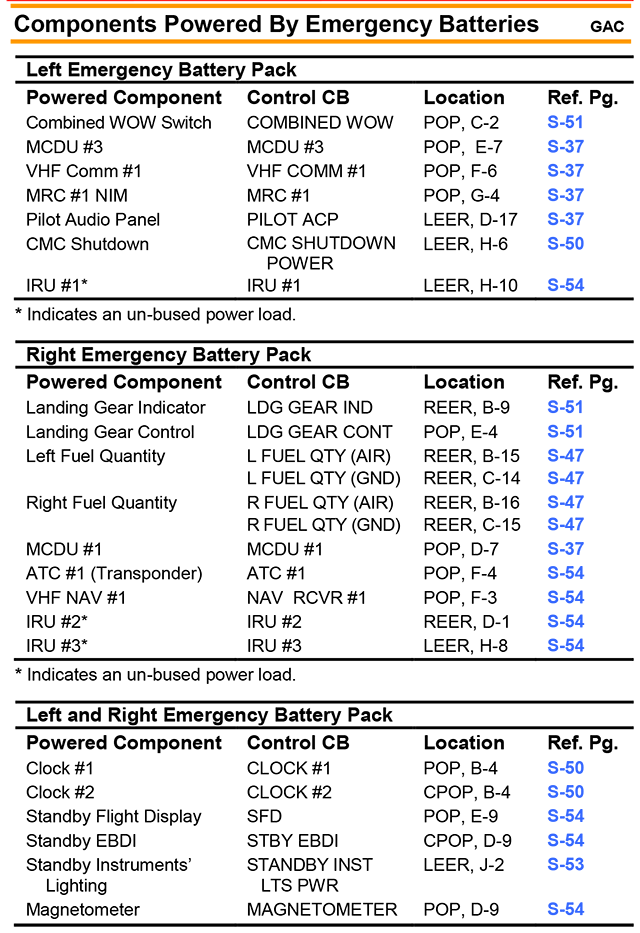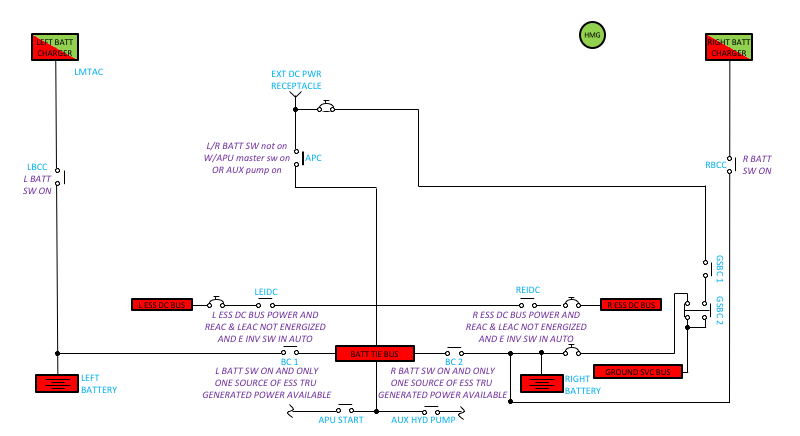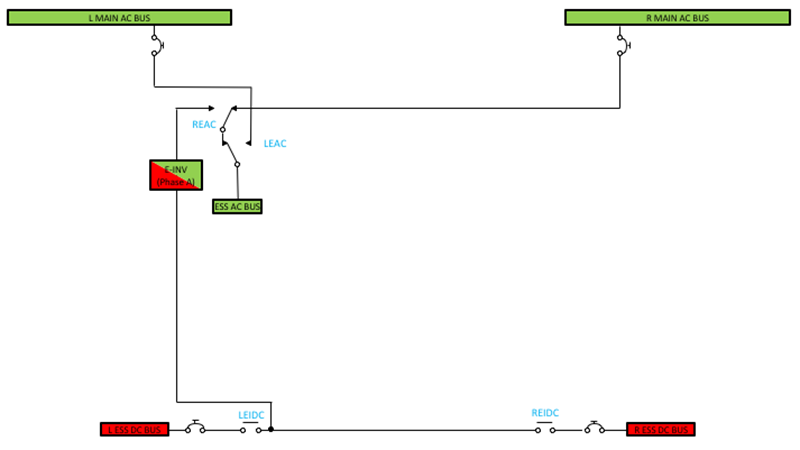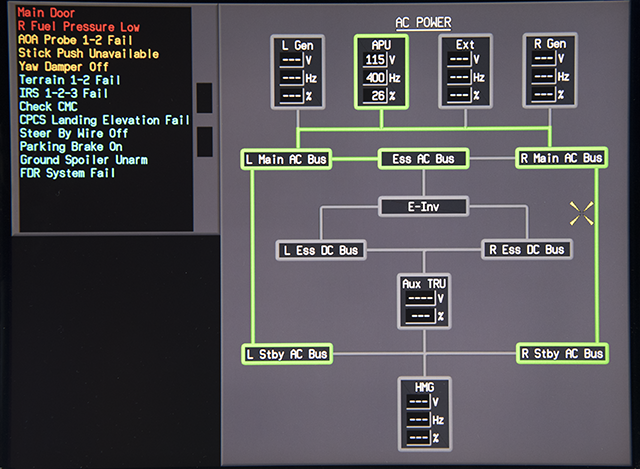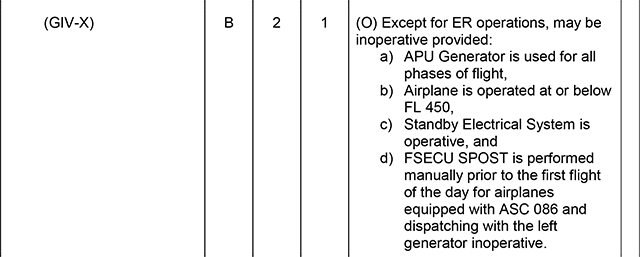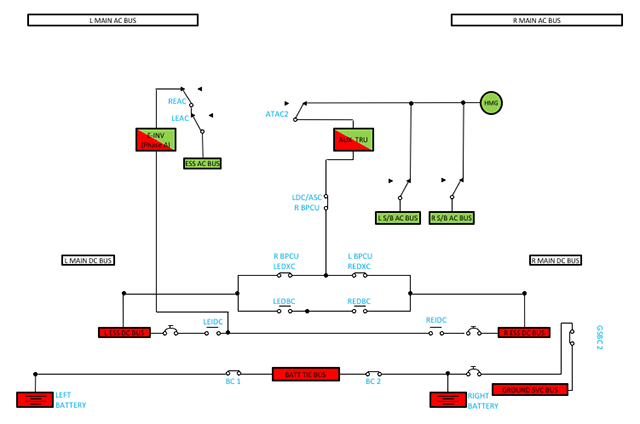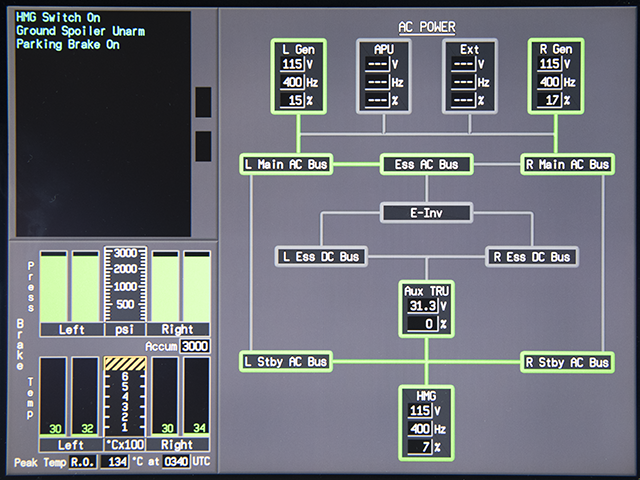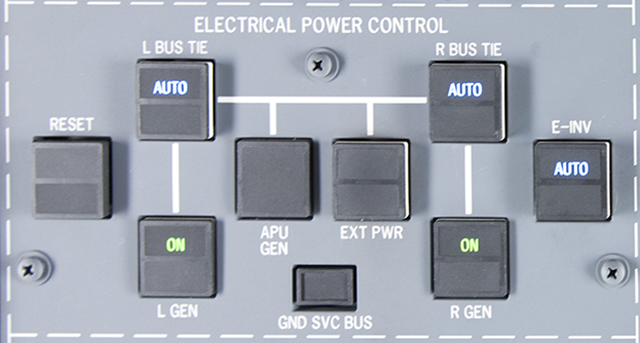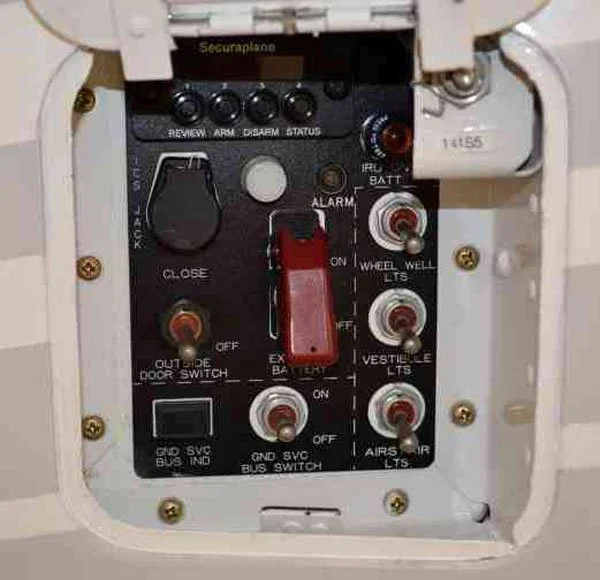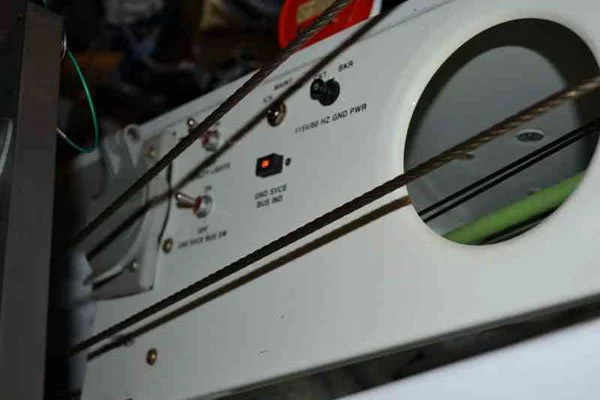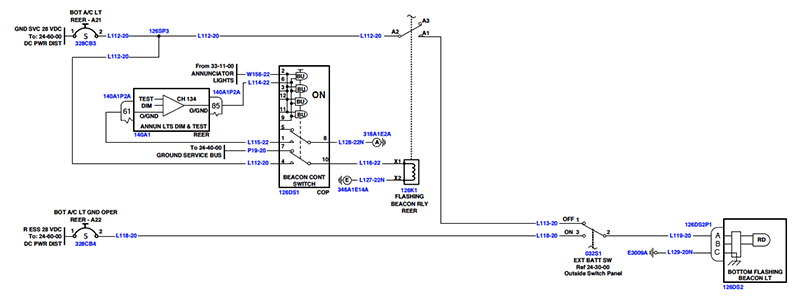Electrical System
- James Albright (a former G450 driver)
Updated: 2017-07-05
The GV electrical system was as near perfection as any electrical system I've ever seen. The G450 has basically the same system with just two drawbacks: a lower output HMG and a lower altitude APU. Other than that, it is very good indeed.
Just need a refresher? Try: G450 Refreshers: Electrical System.
The G450 electrical system can seem daunting at first but it is very well thought out and easy to operate. So easy, in fact, that you don't have to really understand it all. If you are always paired with a strong simulator partner, you can get by knowing absolutely nothing. The system comes on line automatically and off line automatically. But you really ought to understand the magic behind the curtain in case the magician goes on strike.
Everything here is from the references shown below, with a few comments in an alternate color.
A Lesson Plan
If you've flown the GV or G550, the system is identical except the HMG puts out half as much power and the APU is limited to 37,000 feet. You are done.
If you don't have any GV or G550 experience, I think the best way to learn the system is to go through a basic flight where everything comes on line automatically and when you shut down the opposite happens:
Emergency Batteries (eBatts) — the first button you press prior to every preflight: the emergency batteries. From that point they just sit and wait until called.
Aircraft batteries — you use them for various preflight chores, to start the APU, and quite often for auxiliary hydraulic pump action. Then they just sit there and charge until the flight is over or if something goes very wrong.
E-Inverter — there is an emergency inverter that sits back and waits for things to get really bad. So bad, in fact, that you can only test it when the airplane has no AC power on it. So you test this before starting the APU. From that point you will never notice it. But if you ever lose all other AC power, which take a lot of doing, this gizmo will keep you automatically pressurized and power two of your three pitot heaters.
APU generator — the APU generator can run the entire airplane on the ground. In fact, it could in the air too except the cabin is load shed if an engine generator is inoperative while in flight. (For most completions.) It can also be called on in an emergency, but it is altitude limited.
Engine driven generators — each engine has a generator which is identical to the APU generator with the addition of a constant speed drive, becoming an Integrated Drive Generator (IDG). These IDGs have capabilities that make this electrical system a generation ahead of everything that came before.
Of course there are other "normal" situations that you will encounter now and then:
Hydraulic Motor Generator — the airplane has a standby electrical system that is powered by a Hydraulic Motor Generator (HMG) that adds yet another layer of redundancy. You will test this before every overwater flight, so I've included it here.
External AC Power — an external AC power cart can be as good as the APU, except there will be issues going from external AC to the APU generator, you will get a power break. But there is a way around that.
External DC Power — an external DC power cart isn't much better than just having the batteries on, except that the batteries won't drain. They won't charge either.
Once you've mastered that, we can look more deeply into the more technical aspects of the electrical system:
Generator Control — the engine driven generators and, to a lesser degree, the APU generators get along well with the other systems on the airplane and each other. This is all due to the Generator Control Units (GCUs).
Bus Power Control — the electrical system is about as automatic as any I've seen, even under abnormal conditions things tend to happen for the better. Much of this wizardry is due to the Bus Power Control Units (BPCUs).
Transformer Rectifier Units (TRUs) — Most of the electrons consumed on the airplane are DC but just about all of the production is AC. The TRUs allow this to happen.
Power Distribution — The power goes from the power producers to the power consumers through buses, circuit breakers, and switches. Much of the redundancy is automatic, but you do have some degree of control.
Ground Service Bus — There is a final topic worthy of discussion and that is a bus dedicated to doing those things that need to be done on the ground without powering up the rest of the airplane.
Emergency Batteries (eBatts)
Like any airplane that is mostly computers, the G450 is a DC airplane. The easiest way to understand what's important on this airplane is to start with the first electrical switch you press during any preflight: the eBatts ARM switch.
Photo: G450 Left eBatt, brand name "Securaplane" (from Eddie's aircraft)
eBatts: Description
The manuals can be confusing because they aren't consistent about the terminology. For the most part, when we talk about "eBatts" we are talking about four emergency battery packs from the company Securaplane. These are hefty units that weigh about 30 pounds each. There are two designed to keep you flying, navigating, and communicating IFR when everything else fails. The other two are designed to provide emergency lighting. We will cover these eBatts first because they are the first thing you test during a normal preflight and the last thing to go when the chips are down.
[G450 Aircraft Operating Manual, §2A-24-30 ¶2.E.] In the event that the main aircraft batteries become depleted during a failure of all AC generators, two emergency lead/acid batteries are available to power emergency navigation and communication resources. The emergency batteries each have a dedicated charger, powered by the respective left and right standby AC bus. The emergency battery chargers will replenish 80 - 90% of battery charge in an hour, and fully charge the batteries in one and one-half hours.
[G450 Aircraft Operating Manual, §2A-33-60 ¶1.] The emergency lighting system provides illumination to facilitate the safe evacuation of the aircraft during an emergency in low light conditions. The system includes:
Overwing exit lights
Underwing exit lights
Cabin, Floorpath and Airstair Emergency Lights
Emergency lighting battery packs
eBatts: Location
[G450 Aircraft Operating Manual, §2A-24-30 ¶2.E.] The left and right emergency batteries are located in the respective electronic equipment racks (LEER and REER) and are rated at 24V and 9 amperes per hour.
[G450 Aircraft Operating Manual, §2A-33-60 ¶2.D.] Power for the emergency lighting system is supplied from forward and aft Emergency Lighting Battery Packs (ELBPs). The forward ELBP is located in the Right Electronics Equipment Rack (REER) and supplies power to the forward lamps in the overwing exit light assemblies, and to both underwing exit lights. The aft ELBP is located in the Baggage Electronic Equipment Rack (BEER) and supplies power to the aft lamps in the overwing exit light assemblies and both underwing exit lights.
eBatts: What they power
You will often hear an instructor say the eBatts power eight things because you are looking for eight items during the eBatt check. But they power much more than that:
Photo: Components powered by emergency batteries, (G450 QRH, p. EA-15)
Recall that the same types of batteries are used for emergency lighting, so you can add to the list the overwing exit lights, underwing exit lights, emergency cabin lights, and the airstair emergency lights.
eBatts: Switchology
Photo: G450 eBatts control panel, (from Eddie's aircraft)
[G450 Aircraft Operating Manual, §2A-24-30 ¶2.E.] The operation of the emergency batteries is controlled by three switches on the overhead panel labeled EMERGENCY POWER. The three switches select emergency battery power ON, OFF or ARM for automatic supply of DC power should the main batteries fail.
NOTE: The three control switches have split legends, one for the emergency lighting batteries (LIGHTS) and one for avionics power (AV PWR). A dual emergency battery installation provides power for emergency exit and egress lighting if needed, and is controlled with the same switches as the avionics emergency power batteries. The EMERGENCY POWER switch labels and functions are:
ON - when depressed, powers the left and right emergency buses and essential flight instrument bus from the emergency batteries and illuminates the AV PWR amber legend - the AV PWR legend will also be illuminated if the emergency and flight instrument buses are automatically powered by the emergency batteries during main battery failure.
The switch also turns on the emergency lighting. (See G450 Aircraft Operating Manual, §2A-33-60 ¶2.E.) You will hardly ever press this switch in normal operations because the ARM function is needed to test another function of the system.
ARM - when depressed, arms the emergency batteries to power the emergency and flight instrument buses if essential DC bus power drops below 20V indicating main battery failure. When the switch is depressed, the AV PWR legend is not illuminated - the legend illuminates only if the switch is not armed.
The eBatts will come on if the system is armed and the voltage on the essential DC bus goes below 20V, but they will also come on if you press the ARM switch and there is no power on the essential DC bus to begin with. You will do that for every preflight to test the 20V relay.
OFF - the emergency batteries may be selected off provided that there is more than twenty volts (20V) present on the essential DC buses. If the switch is depressed, the AV PWR legends of the OFF and ARM switches will illuminate amber.
You need 20V or more on the essential DC bus to allow the eBatts to turn off.
eBatts: How long they last in an emergency
There are ground school instructors who will tell you the eBatts are guaranteed to last 90 minutes. I think they are probably confusing the discharge rate with the charge rate. I've not seen a definitive answer to this anywhere. The closest thing to an answer from a reliable source comes from Securaplane literature which hints these batteries will last one hour.
eBatts: MEL implications
Photo: G450 eBatt MMEL entry, (from Gulfstream GV MMEL, p. 24-8)
The avionics Emergency Batteries are called "IRU Backup Batteries" in the Minimum Equipment List (MEL). [G450 MMEL, page 24-8 Item 16] Gulfstream told me the FAA would not approve an MEL item to anything called "emergency," so they changed the name in the MEL because they wanted to be able to dispatch with a bad eBatt. But do you really want to go without one? The MEL says you can go without one eBatt: "May be inoperative provided that the affected battery is located in the #2 or #3 IRU back up battery position." Of course if you want to play that game, that would be the Right eBatt and going without that means you don't have a back up for your landing gear position indicators, fuel quantity, #1 MCDU, ATC #1, and VHF #1. Your call. There is no provision for MEL relief on the lighting eBatts.
eBatts: Schematic
The G450 electrical system is almost identical to that in the GV and that's where this rather complicated schematic comes in. Relax, you don't need to memorize this. But in the early days of the GV we did have to memorize this because that's what you did back then. Early Gulfstream electrical systems (GIV and prior) were problematic and you almost needed a degree in electrical engineering to fully trouble shoot it. And you had to trouble shoot it often.
Photo: G450 electrical system schematic, (from Eddie's notes)
Fast forward to the GV and after a few years everyone figured out the system is practically bullet proof. So we'll get into this schematic a little later, just to give you the big picture. For now, let's look at a much simpler schematic:
Figure: G450 eBatts, (Eddie's notes)
What you must understand is that all the components we think are powered by the eBatts are actually powered by the left and right essential DC buses. In normal operations, electrons from the left or right essential DC buses go through a diode (that prevents reverse flow of electricity) to the component in question. The eBatt, in this condition, does nothing but sit and keep charged by the left or right standby AC bus. It is an ingenious system in that once it is armed, it just sits there and waits. So don't let a simulator instructor tell you that the clocks, for example, are powered by the eBatts. Bet him or her a beer that this isn't true and then turn off the eBatt. As long as that essential bus is powered, the clock keeps running.
eBatts: If that's all you've got . . .
Photo: G450 cockpit on eBatts only, (from Eddie's aircraft)
You have enough to keep the airplane right-side-up (with the SFD), monitor the engines (with MCDU1), talk on the primary radios (with MCDU3), and shoot an instrument approach (with the SFD and EBDI). You ought to try this in the simulator now and then.
eBatts: The non-eBatt emergency batteries
[G450 MM, §33-54-00, ¶1.A.] The emergency floorpath lighting system, installed on the aircraft during the completion process, provides passengers and crew an illuminated evacuation path providing guidance to exits in event of an emergency or loss of aircraft power. In darkened or smoke filled cabin, white aisle lights illuminate the exit path, red lights signify the need to stop and look for an exit and illuminated exit arrow signs point to the nearest emergency exit. The 28 Vdc power for the floorpath lighting is provided by three batteries dedicated to the system. The batteries are charged through the FLOOR PATH circuit breaker anytime the main cabin dc bus is powered. The circuit breaker is located in the INTERIOR LIGHTS section of the cabin circuit breaker panel.
[G450 AOM, §2A-33-60, ¶2.C.] Floorpath lighting is installed to indicate paths to emergency exits should the cabin visibility be reduced by smoke, flame or fumes. The floorpath lighting is powered by a dedicated system of three batteries that provide overlapping power sources to the lights ensuring that a visible exit route is always available.
These are installed during completion and any manuals should have been provided at that time. This is a trivia question that is often answered incorrectly twice:
"How many emergency batteries do we have?"
"Four (the four eBatts).
"Wrong! There are also three emergency floorpath lighting dedicated batteries so the correct answer is seven!"
Well ponder this. There is a D-cell battery behind each emergency exit sign over each overwing emergency exit. You can see a drawing of them in the G450 MM, §33-51-00, figure 402. This manual doesn't explain how these batteries get their charge and they aren't mentioned at all in any of the pilot manuals. So that raises the count to eleven. There are four more D-cell batteries in the ELT. So fifteen. But wait! What about the batteries in each flashlight? Yes, the entire series of questions is silly.
Photo: G450 cabin window emergency exit lights, (from G450 Maintenance Manual, §33-51-00, fig. 402)
Aircraft Batteries
The aircraft batteries are hardly ever on. In fact, you, the pilot, only use them to start the APU and operate the auxiliary hydraulic pump. But if the normal sources of power to the essential DC buses should fail, the APU jumps in as an emergency power source.
Aircraft Batteries: Description
[G450 Aircraft Operating Manual, §2A-24-30 ¶2.D.]
The batteries are rated as 24V DC, 45 amp/hour. During normal operations, the main batteries are used to power the essential DC buses prior to starting the APU to provide APU fire detection and fire extinguishing. (The APU start contactor is powered only by the left battery during the starting process unless the left battery is manually selected off or not connected or installed, in which case the right battery will power the APU start contactor).
This is different than other GV series aircraft. In the G450, the left battery starts the APU unless you have the left battery switch off, in which case the right battery automatically takes the load.
Main aircraft batteries can also power the auxiliary hydraulic pump in order to pressurize the parking brake, close the main cabin door and perform ground maintenance. When the aircraft is on the ground (weight-on-wheels), the right main aircraft battery is also used to power the ground service bus for aircraft servicing and lighting.
Two battery chargers, one for each battery, are also located in the tail equipment compartment. The battery chargers operate as TRUs, converting 115V, 400 Hz, 3Ø AC into 28V DC to maintain main battery charge. The left charger is powered by the left main AC bus, the right charger by the right main AC bus. The chargers will begin to operate if battery voltage drops to 23V and will replenish an almost discharged battery in approximately 90 minutes. The main battery chargers will also aid in starting the APU or powering the AUX hydraulic pump by providing an extra 40 amps in addition to battery power, provided the main AC buses are powered. This feature could also be employed in the unusual circumstance of loss of TRU input to the essential DC buses, requiring the batteries to power essential DC with main AC TRUs powering the main DC buses. Protective features in the battery chargers will prevent damage to the aircraft batteries.
Aircraft Batteries: Location
[G450 Aircraft Operating Manual, §2A-24-30 ¶2.D.] Two (left and right) lead / acid main aircraft batteries are located in the unpressurized equipment compartment in the tail of the aircraft.
Photo: G450 aircraft batteries, (from Eddie's aircraft)
The batteries are rather heavy, about 90 pounds each. Unlike some aircraft, we do not ordinarily disconnect them between flights. (In twenty-plus years of flying Gulfstreams, I have never disconnected the batteries except to replace them.)
Aircraft Batteries: What they power
The batteries are connected to their own, dedicated chargers and to the battery tie bus. Relays connect the left battery to the APU starter unless the left battery switch is off, in which case it uses the right battery. The right battery is normally connected to the APU ECU. The right battery is connected directly to the ground service bus through various switches. The essential DC buses connect to the battery tie bus when needed. Notice that external DC can connect to the battery tie bus, but not to the batteries themselves. (Which means you cannot charge the batteries through external DC.)
Photo: G450 aircraft battery connections, (from Eddie's notes)
Notice also that the HMG is involved somehow. There is a circuit breaker on the REER connected to L BATT BUS A that goes to HMG CONT#2 and another on the AUX PWR RLY BOX connected to R BATT BUS B that also goes to HMG CONT#2.
Aircraft Batteries: Switchology
Photo: G450 aircraft battery panel, prior to APU start, (Eddie's aircraft)
When you first turn on the battery switches on a cold G450 (no electrical power at that point), the battery "ON" indications will illuminate because the essential DC buses have no other power source and will draw from the battery. You need at least 22V on at least one of the batteries to start the APU. More about this: G450 APU Start Checklist. (If the left battery is below 22V and the right is above, you must turn the left battery switch off to start the APU using the right battery.)
Photo: G450 aircraft battery panel, during APU start, (Eddie's aircraft)
Even if you are operating with the engines providing all electrical power to the airplane, starting the APU will cause the battery switch lights to indicate "ON" and cause a significant drop in voltage with an increase in the amperage draw. Both of these numbers will recover once the APU starter cuts out and even more so once the APU generator comes on line.
Photo: G450 aircraft battery panel, while batteries charging, (Eddie's aircraft)
[GV Aircraft Operating Manual, §2A-24-30 ¶2.D.(2)] Each battery charger provides temperature-compensated charging in the Charge mode, or an output of a constant 28V DC in the Transformer-Rectifier mode of operation. In the Charge mode, the battery chargers initiate a charge cycle in a constant current mode. The output voltage will vary with battery state-of-charge and battery temperature. Initially it is approximately 28V DC, and the current will be approximately 38 Amps. As the battery state-of-charge increases, the output voltage increases to 32 volts, then drops to 28 volts. After this drop, the charger is in the constant voltage mode.
This AOM verbiage was dropped from the GV to the G450 but appears to be somewhat true nonetheless. After you start the APU you should see the voltage steadily climb, meaning the batteries are charging. I've never seen it get to 32V but I have seen 30V. Once charged, the meters return to approximately 28V.
Photo: G450 aircraft battery panel, after batteries fully charged, (Eddie's aircraft)
[GV Aircraft Operating Manual, §2A-24-30 ¶2.D.(2)] In the Transformer-Rectifier (TR) mode of operation, the output is 28V DC, at up to 50 Amps.
Once the batteries are fully charged, the battery charging TRUs go to TRU-only mode, and produces up to 40 amps in the G450, to meet any other needs on the battery buses.
Aircraft Batteries: Synoptic Pages
Photo: G450 DC electrical synoptics, battery power only, (from Eddie's aircraft)
This is our first look at an electrical system synoptic, specifically the DC Power synoptic page. The sources of DC electrical power are on the top and bottom. Once you turn the batteries on, electricity goes up the two most important buses on the airplane, the left and right essential DC buses, "L Ess DC Bus" and "R Ess DC Bus" on the synoptic.
Aircraft Batteries: How long they last in an emergency?
[G450 Aircraft Operating Manual, § 2A-24-30 ¶2.C.] In addition to the major DC buses, battery powered buses will support essential and emergency equipment with 28V DC power for a limited time if all AC power and associated TRU supplied DC power is lost. Two (left and right) main aircraft batteries are connected to the Battery Tie Bus with push button switches on the overhead panel. Even though the left and right main battery push buttons are depressed to select each battery ON, the ON legend in the push button will not illuminate unless the batteries are actually supplying power to one or both of the essential buses. The dual battery output of the Battery Tie Bus is then available to power all the normal loads of the left and right essential DC buses should a malfunction cause a loss of all TRU supplied DC power. The left essential DC bus normally powers the left emergency DC bus and the flight instrument bus. The right essential DC bus normally powers the right emergency DC bus.
The main aircraft batteries are capable of powering the essential buses for approximately 30 minutes, including two attempts to start the APU (the start attempts must be less than thirty (30) seconds each). If the main aircraft batteries are depleted, two (left and right) emergency batteries will power the left and right emergency buses and the flight instrument bus.
[G450 Aircraft Operating Manual, § 2A-24-30 ¶2.D.] Two battery chargers operate as TRUs, converting 115V, 400 Hz, 3Ø AC into 28V DC to maintain main battery charge. The left charger is powered by the left main AC bus, the right charger by the right main AC bus. The chargers will begin to operate if battery voltage drops to 23V and will replenish an almost discharged battery in approximately ninety (90) minutes. The main battery chargers will also aid in starting the APU or powering the AUX hydraulic pump by providing an extra 40 amps in addition to battery power, provided the main AC buses are powered. This feature could also be employed in the unusual circumstance of loss of TRU input to the essential DC buses, requiring the batteries to power essential DC with main AC TRUs powering the main DC buses.
Aircraft Batteries: MEL implications
Photo: G450 MMEL, aircraft batteries, (GV MMEL, §24, p. 24-3)
You have two, you need one.
Aircraft Batteries: If that's all you've got . . .
Photo: G450 cockpit on aircraft batteries only, (from Eddie's aircraft)
You will have DU1 and DU4 with batteries only and will be in pretty good shape for as long as they last. You will even have synoptics. See: G450 Avionics / Two Screen Synoptics for how.
E-Inverter
There isn't much on the essential AC bus, in fact, there are only 8 circuit breakers. Have I mentioned this is a DC airplane? Nevertheless, there are a few things on Phase A of the Essential AC bus that are critical so we have a way to back them up. You will also need to test that back up system before you start the APU.
E-Inverter: What's on the bus?
Photo: G450 essential AC circuit breakers, (from G450 QRH, p. S-20)
All of the important stuff is on Phase A. Single phase (ØA) versus three-phase (ØA, ØB, and ØAC)? For an explanation of three-phase see: Three-phase Electrical Power. What you need to know here is that the E-Inverter does not power the entire Essential AC bus, only a third of it. What it gives you, if you lost power to the AC Essential is: Cabin Pressure Channel 1, the right pitot heaters, and the standby pitot heaters.
E-Inverter: Switchology
Figure: G450 electrical system panel, (from Eddie's aircraft)
[G450 Aircraft Operating Manual, §2A-24-00, figure 10] E-INV
AUTO (Blue): If L/R Main buses fail, Left or Right Essential DC buses will supply power to the E-Inverter, which will supply power to Phase A of the Essential AC bus.
OFF (Amber): E-Inverter cannot receive power.
The only control you have is to keep the essential AC bus from connecting to the E-Inverter.
Essential AC Bus: Normal Power Sources
The essential AC bus is normally powered through a relay identified as LEAC from the left main AC bus. This relay automatically moves to the left main AC bus through something called a Hall Effect Sensor that senses the presence of current on the left main AC bus. There is no pilot control available: if you have power on the left main AC bus, that is where the essential AC bus is getting it.
Figure: G450 Essential AC normal power source, (from Eddie's notes)
If, for some reason, the left main AC bus is unpowered, the LEAC relay will be deenergized to the left (on the diagram) seeking power from someplace else. The REAC relay always favors power from the right main AC, so the essential AC bus will then get its power from the right main AC through the two relays.
Figure: G450 Essential AC power source from right main AC, (from Eddie's notes)
If, the right main AC bus is also unpowered, the REAC relay falls to the left (on the diagram) and gets is power from the E-Inverter.
Figure: G450 Essential AC power source from E-Inverter, (from Eddie's notes)
E-Inverter: Testing
Step 8 of the G450 APU Start Checklist says this:
Essential AC-Bus Fail CAS Message . . . VERIFY NOT DISPLAYED
and we also have this:
[G450 Aircraft Operating Manual, §2A-24-20 ¶2.F.] An Emergency Inverter (E-Inverter) powered by the DC essential buses will provide single phase (ØA) AC power to the essential AC bus with the loss of all AC power sources. (The essential DC buses are powered by either the HMG, or if not available, aircraft batteries in this instance.) The E-inverter is controlled with the E-INV push button switch on the cockpit overhead. The switch is normally positioned to the AUTO selection so that the E-inverter will be automatically powered by essential DC if all generators are lost. The OFF switch position will remove power from the E-inverter if a malfunction prompts a nuisance activation.
I don't think there is anything magical about the APU fire bottle test other than it is a good time (and the last time) to check for this CAS message. If you don't have the DU powered because of temperature concerns, looking for the pressurization panel indicates the system isn't powered and would also indicate a relay or E-Inverter problem. More about this next:
E-Inverter: Synoptic Page
Photo: G450 AC electrical synoptics, battery power only, (from Eddie's aircraft)
The AC synoptic page can be confusing because there are DC components. In this case, the DC components can be considered to be sources of power, not consumers. The entire top row — L Gen, APU, Ext, R Gen — are producers of AC power. So is the bottom item, the HMG. (More on that below.) The entire middle section, between the Aux TRU and E-Inv, combine to produce power for the Ess AC Bus.
APU Generator
With the APU running on the ground, you have every electron needed at your disposal. (It can run the entire airplane electrically, even when providing bleed air for air conditioning.) In the air, the APU isn't used for bleed air but can run all the electrical needs with one exception. With either aircraft engine generator inoperative, parts of the cabin and/or galley will load shed. (This can vary, depending on how the aircraft was completed.)
The APU Generator
Photo: G450 APU generator, (G450 Maintenance Manual, §24-22-01, figure 401)
[G450 Aircraft Operating Manual, §2A-49-20 ¶2.G.]
An oil-cooled generator mounted on the APU gearbox provides a source of AC power for use on the ground or in flight if an engine-driven generator is not available. The APU generator produces three phase (3Ø) 400Hz 115/120v and can deliver up to 40kVA. The producing capacity of the generator is identical to those mounted on the aircraft engines - the only difference is that the APU generator does not have an Integrated Drive transmission since the APU operates at a constant speed (rpm). The generator can provide a full 40kVA output up to the limit of the APU operating envelope of 37,000 ft.
When the APU has reached an operating rpm of 95% for at least 4 seconds, the APU is capable of driving the generator. The APU generator has a GCU that monitors the voltage output and phase sequencing of the generator. If the output of the generator is within acceptable parameters, and the APU is at operating rpm, the ECU determines that the APU generator is ready to assume aircraft electrical loads. The APU generator can be selected on or off using a switch button labeled APU GEN on the ELECTRICAL POWER CONTROL panel on the cockpit overhead. The amber ON legend within the switch button will illuminate when the APU generator is in use. The APU generator GCU will drop the generator off line if the quality of power produced by the generator falls outside of normal parameters.
APU Generator: The Synoptics
Photo: G450 AC Electrical Synoptics, APU Running, (Eddie's aircraft)
This synoptic can be confusing. Think of the output of the APU flowing downstream to the Left Main AC, Right Main AC, and the Essential AC buses. The Main AC buses feed the standby buses. The blank HMG on the bottom is not functioning, but when it does, it pushes its output upward to feed the AUX TRU which in turn, feeds the essential DC buses. The HMG is blank because it isn't on, the Aux TRU is blank because it isn't being powered by the HMG, the essential DC buses are blank for the same reason. The E-Inverter is blank because it isn't being powered by either DC essential. On the top row, the engine generators are not spinning because the engines are not yet running and the External AC is not connected. You need to look at one more screen:
Photo: G450 DC Electrical Synoptics, APU Running, (Eddie's aircraft)
The DC page is fully functional with the APU running. The only blank spot is the external DC, which is not hooked up.
APU Generator: Switchology
Photo: G450 AC Electrical Synoptics, Engines Running, APU Shut Down, (Eddie's aircraft)
The APU GEN control switch is normally left pressed in the "ON" position. If the APU is not running, the amber "ON" will be blank. As the APU comes up to speed and has reached 95% RPM for at least 4 seconds, the generator makes itself available and will come on line if the engine driven generators are not on line. (The amber "ON" illuminates.) During engine shutdown, if the APU generator is on line, it will come on line automatically. Cycling the switch will "reboot" the APU Generator Control Unit (GCU). In other words, you will normally never touch this switch unless something has gone wrong.
APU Generator: MEL implications
Photo: G450 MMEL, APU generator, (GV MMEL, §24, p. 24-1)
Photo: G450 MMEL, APU, (GV MMEL, §49, p. 49-1)
You don't need the APU at all if both engine driven generators are okay, the HMG is okay, and you find another way to start the engines.
ER Operations
What about that "ER operations" note? You aren't going to find an explanation in the MMEL, but if you look in the MOPP you find this:
[GV MOPP, p. F-15] The FAA recently revised 14 CFR to address Extended Operations (ETOPS) of Multi-Engine Airplanes. The new rule applies to GAC airplanes operated under 14 CFR Part 135 on stage lengths where the single engine cruise segment exceeds 180 minutes. On those flights, the MMEL becomes more restrictive for certain items. Those items have been identified in this MMEL revision by the words, "Except for ER operations, . . .”.
So unless you are flying under 14 CFR 135 the "ER operations" doesn't apply to you. But even if you are operating commercially, the 180 minute rule isn't as cut and dried as it seems.
APU Generator: If that's all you've got . . .
Photo: G450 cockpit on APU power, on the ground, (from Eddie's aircraft)
The APU generator can run the entire airplane on the ground without breaking a sweat or causing you to break a sweat because it can handle the entire electrical load while providing air conditioning bleed air. A normal engine ground start will shut down the air conditioning packs, but that's about it. In flight, the G450 APU is not used for bleed air but can handle all of the electrics except for the cabin, which will load shed with either engine generator inoperative.
Engine driven generators
Each engine has an Integrated Drive Generator (IDG) fully capable of running the entire aircraft. Not only that, they are so fully automatic you will never have to deal with them, except in the simulator. And even there they are pretty simple.
What's an IDG?
[G450 Aircraft Operating Manual §2A-24-20 ¶2.A.] The aircraft engines each turn an IDG though a transmission mounted on the engine accessory gearbox at the compressor section of the engines. The IDGs are driven at a constant speed of twelve thousand (12,000) rpm regardless of engine speed through a hydromechanical transmission coupling the generator to the engine. A constant rotational speed enables the Generator Control Unit (GCU) to maintain AC power parameters of three phase (3Ø) 115/200 volts at 400 cycles-per-second (Hz) and deliver up to forty thousand volt / amps (40kVA). The IDG rotates whenever the engine is operating. There is no provision for disconnecting the IDG from the engine while in flight.
So an IDG is a CSD clamped between the generator and the engine to give you a constant 400 cycles per second frequency no matter the engine speed. But this particular IDG is even smarter than that. It can adjust those frequencies to match that of a parallel source, such as the APU or external AC power. Each generator puts out 115/200 volts over three phases.
What's a phase?
Photo: G450 left engine IDG, (Eddie's aircraft)
If you look at the photo of the IDG you will see four heavy cables. One of those cables is the ground wire and each of the other three cables puts out 115V AC power. If you imagine the alternating current of the AC power as a sine wave, think of each phase differing from the others by a third. This limits the peak voltage and allows these cables to be smaller. If you add the three phases together you get 200V, hence the 115/200V nomenclature. More about this: Three Phase Electrical Power. From a pilot's perspective you only need to know this: most of your equipment only needs a single phase and you will see them listed as ØA, ØB, or ØC. Equipment that has larger demands will actually need all three.
Engine Driven Generators: Switchology
Photo: G450 electrical control panel, engines running, APU Shut Down, (Eddie's aircraft)
The generator control switches are normally left pressed to the "ON" position. If the engine isn't running, you will see an amber "OFF" illuminated. Once the engine comes up to speed the generator will bring itself on line and the switch capsule changes to a green "ON" legend. Upon engine shut down the generator will take itself off line.
Engine Driven Generators: The Synoptics
Photo: G450 AC Electrical Synoptics, Engines Running, APU Shut Down, (Eddie's aircraft)
With both IDGs providing electrical power, everything on the airplane that needs power will have power. In the example shown above, the APU GEN switch light is amber because the APU generator switch is in the "ON" position, as it always is, but it isn't running. The HMG is not providing power to the AUX TRU which is not providing power to the DC essentials, neither of which is powering the E-Inverter; which is why they are all gray on the AC page.
Generator Cooling
The engine driven generators contain oil that is cooled with engine bypass air. The IDG oil is cooled by a fuel heat exchanger.
Figure: G450 generator air cooled oil cooler (#15), (G450 Maintenance Manual, §24-12-01, figure 401)
[G450 Maintenance Manual, §24-10-00 ¶3.A.] The engine generator oil cooling subsystem accepts hot oil from the IDG and cools it with air from the engine bypass duct. The oil cooling system consists of an air cooled oil cooler and interconnecting oil transfer tubes and fittings.
Figure: G450 combined fuel cooled oil cooler, (G450 Maintenance Manual, §79-22-01, figure 402, sheet 1)
[G450 Maintenance Manual, §73-00-00 ¶4.A.(1)] The Integrated Drive Generator (IDG) requires oil cooling of its of its independent integral oil system and has a dedicated fuel cooled oil cooler supplied with LP fuel located to the engine fuel cooled oil cooler. At lower fuel flows particularly combined with high generator load the IDG oil heat transfer can be excessive therefore a surface air cooled oil cooler is located in the bypass duct. Fuel filtration and system protection from ice particles is provided by a non-cleanable filter. Additional heating to prevent filter ice formation is given by HP return fuel directed around the housing.
[G450 Airplane Flight Manual, §1-24-20] The Integrated Drive Generator (IDG) electrical load is limited to 45% (18 kVA) when ambient temperature is greater than 110°F / 43.5°C in order to maintain steady state fuel temperatures below 95°C.
We rarely see a generator exceed 25% of its capacity so operating above 110°F ambient temperature should not be a problem with both engines running or the APU with or without either engine.
Engine Driven Generators: MEL implications
Photo: G450 MMEL, engine generators, (GV MMEL, §24, p. 24-1)
If you have an APU generator available, an HMG available, and you remain below the aircraft's service ceiling, you can go without one engine driven generator.
Hydraulic Motor Generator (HMG)
If you find yourself down to the eBatts or the batteries, which are DC power sources, you also have the APU to provide a very large (40 kVA) source of electrical power. But that means you will have to descent to 37,000 feet or lower. And what if you had to MEL the APU or generator? The standby electrical system gives you a single Hydraulic Motor Generator (HMG) that can power both essential DC buses and both standby AC buses. While the HMG doesn't provide as many buses as the APU, it doesn't have any altitude limits.
HMG: Description
[G450 Aircraft Operating Manual, §2A-24-20 ¶2.E.] If failures and/or malfunctions preclude the use of engine and APU generators for electrical power, a hydraulic motor generator (HMG), located in the tail compartment, may be used as an AC electrical source. The HMG and associated buses are termed the Standby Electrical System and are controlled with cockpit overhead push button switches. When the HMG is selected ON with the STANDBY ELECTRICAL POWER MASTER switch, a solenoid valve opens, allowing pressurized left system hydraulic fluid to rotate the variable piston drive of the generator. The generator has a GCU that is initially powered by 28V DC from the left essential bus or the right battery bus, depending upon system availability.
Once the HMG reaches normal operating speed of 8,000 rpm, the GCU uses generator PMG power for control functions. The HMG is capable of 5kVA of three phase (3Ø) 115V 400 Hz power, however actual power generation level is dependent upon hydraulic system output that is in turn a consequence of engine power setting. The GCU controls voltage to 115V ±2, and provides standard protective functions (over / under voltage, frequency and speed). A time delay of up to 6 seconds prior to tripping the generator accommodates fluctuations in left hydraulic system pressure associated with the actuation of other hydraulic system components. The overspeed trip is not delayed, since this condition would not be caused by a hydraulic pressure decrease. Thermal overload sensors will signal the GCU to drop the HMG off-line if high demand results in overheating.
NOTE: An HMG overload trip requires a manual reset, cycling the STANDBY ELECTRICAL POWER MASTER switch OFF, then ON.
The primary purpose of the HMG is to provide an AC power source to the AUX TRU. The two AC Standby buses will also be powered by the HMG if main AC is lost, and feed a limited number of AC installations, including pitot heat, TAT heat, flap / stab power and emergency battery chargers. The AUX TRU provides a DC power source to energize the DC essential buses powering the flight instruments, navigation and communication radios necessary to maintain flight with the loss of AC power.
Figure: G450 electrical system schematic, HMG and battery only powered, (from Eddie's notes)
HMG: Location
Photo: G450 HMG, (from Eddie's aircraft)
Unlike the GV and G550, the HMG in the G450 can be found in the tail compartment. (It had to be moved there to offset the addition 1-1/2 feet of cockpit in the G450 beyond what was found in the GIV.)
HMG: Switchology
Photo: G450 standby electrical panel, (from Eddie's aircraft)
The best way to understand what the switches do is to consider a dual generator failure. We'll take up the procedure at step 6.
[G450 Airplane Flight Manual, page 04-04-10]
If Left System (L SYS) or PTU hydraulic fluid and the Standby Electrical Power System (HMG) are available, proceed with Step 6.
If L SYS or PTU hydraulic fluid is not available, the Standby Electrical Power System (HMG) will not be available, proceed to Step 14.
6. Standby Electrical Power System (HMG) MASTER . . . ON
NOTE: To avoid shock loading the HMG, make each ESS switch selection one at a time. Allow at least ten (10) seconds between each selection to allow HMG loads to stabilize.
7. Standby Electrical Power System (HMG) L / R ESS Switch(es) . . . ON
When you press the MASTER switch, hydraulic pressure is ported to the HMG motor. It will take it a few seconds to come up to speed but as soon as it does, you will see the HMG and both standby AC buses on the synoptic turn green. This will be followed almost immediately by the Aux TRU. You are now powering the Aux TRU and the standby AC buses.
HMG: The Synoptic
Photo: G450 AC Electrical Synoptics, HMG Test, (Eddie's aircraft)
Note that the power transfer on the standby AC buses is a break power transfer, there will be a momentary interruption of power. But the only thing on these buses are TAT probe heaters, eBatt battery chargers, and a secondary stab motor.
The next two switches, when pressed, will power the essential DC buses. These are very large draws and if done simultaneously, could cause the HMG to spool down momentarily. In my opinion, the 10 second warning only applies to the last switch. Here is my logic: you press the first switch and wait for the HMG to come to speed, that might be ten seconds but it might be less. Once that happens you can immediately press the L ESS switch. Now you wait ten seconds. Then you get the R ESS switch.
HMG: Limitations
[G450 AFM, §1-24-10] When the Standby Electrical Power System (HMG) system is in operation, speed brakes may be used provided operation is slow (approximately 3 seconds for full range movement).
This limitation is designed to keep the HMG from dropping off line as a result of a large draw of hydraulic pressure from the speed brakes.
The G450 HMG is identical to the GV/G550 HMG:
From: G450 Illustrated Parts Catalog ¶ 24-24 and the GV Illustrated Parts Catalog ¶ 29-20]
The G450 HMG is "limited" to half the power of the G550 HMG because the G450 engine-driven hydraulic pumps produce about half as much volume of fluid.
[G450 Aircraft Operating Manual, §2A-29-20 ¶2.A.] Hydraulic pump output is rated at 3,000 psi at a pump rpm of 3,750 producing a flow of 25 gpm. Actual flow rates vary between 10.5 gpm at engine idle and 21.3 gpm at maximum engine thrust.
[G550 Aircraft Operating Manual, §2A-29-20 ¶2.A.] Hydraulic pump output is 3,000 psi at flow rates between 18 gpm at engine idle and 28 gpm at maximum engine thrust.
HMG: Ground Test
[G450 Aircraft Operating Manual, §2A-24-20 ¶2.E.]
Operation of the HMG GCU may be tested without starting the HMG by activating a test switch on the OBSERVER AND TEST MONITOR panel. Pushing the button will illuminate a blue TEST legend in the top half of the button for the duration of the test, approximately 5 seconds. A successful test is indicated by a green GCU OK legend illuminated in the bottom half of the button. After the conclusion of the test, the button must be selected off.
Do not press the L ESS or R ESS switches during the test. While DC power doesn't suffer the same problems with the AC power break, you could risk other complications with all those computers receiving DC essential power.
HMG: MEL Implications
Photo: G450 MMEL, HMG, (GV MMEL, §24, p. 24-7)
You can go without it, but you will need both engine driven generators and an APU generator to do that.
Additional Power Sources: External AC
External AC is just as good as having the APU running.
External AC: Hook Up
Photo: External AC and DC power connections, (Eddie's aircraft)
[G450 Aircraft Operating Manual, §2A-24-20 ¶2.I] An external AC power source may be connected to the aircraft for ground servicing and/or maintenance. The AC receptacle is located on the lower right side of the aircraft fuselage, forward of the right wing.
External AC: Quality Control
[G450 Aircraft Operating Manual, §2A-24-20 ¶2.I] When external AC power is plugged into the receptacle, the left BPCU first monitors the power source for quality parameters, and when requirements are met, illuminates the AVAIL legend on the EXT PWR push button on the ELECTRICAL PANEL. (External power parameters may be visually monitored on the AC Power 2/3 synoptic page or the AC / DC Power Summary 1/6 system page.) Selecting external AC power ON with the EXT PWR switch will power all buses of the aircraft electrical system. The left BPCU continues to monitor external AC for fault protection, and will drop external AC from the aircraft electrical system if a malfunction occurs. External AC power will be dropped after a short time delay for any of the following fault conditions:
Overvoltage - more than 125.5 (±1.5) volts
Undervoltage - less than 102.5 (±2.5) volts
Underfrequency - less than 380 (+5/-0) Hz
Overfrequency - more than 420 (+0/-5) Hz
Overcurrent - more than 122 (+5) amperes
Phases out of sequence
Open or short in Current Transformer
Failure of the Central Processing Unit (CPU) in the right BPCU
External AC: The Synoptic
Figure: G450 AC synoptics, external AC power, (from Eddie's aircraft))
External AC will power the entire aircraft.
External AC: Switchology
The external power switch light will illuminate "AVAIL" when AC or DC external power is plugged into the aircraft and the corresponding BPCU senses the power's parameters are acceptable.
If both sources are plugged in, the AC is connected and the "AVAIL" remains illuminated.
Additional Power Sources: External DC
External DC: Hook Up
[G450 Aircraft Operating Manual, §2A-24-10 ¶2.B.] An external DC power supply may be connected to a receptacle on the forward right lower fuselage for APU starting or powering the ground service bus for servicing, maintenance or preflight inspections.
External DC: Quality Control
[G450 Aircraft Operating Manual, §2A-24-30 ¶2.B] The right BPCU monitors the quality of ground external DC power when it is plugged into the aircraft. Aircraft buses and associated equipment are protected from the same fault conditions as when DC power is provided by TRUs, except that the overcurrent fault parameters are set at 300(+20) amps. If the right BPCU determines that external DC power is within usable parameters, a discrete signal is sent to illuminate the blue AVAIL legend in the EXT PWR switchlight. The AVAIL legend will extinguish and the amber ON legend will illuminate when
External DC: The Synoptic
Figure: G450 DC synoptics, external DC power, (from Eddie's aircraft))
External DC: Switchology
The external power switch light will illuminate "AVAIL" when AC or DC external power is plugged into the aircraft and the corresponding BPCU senses the power's parameters are acceptable.
If the "AVAIL" caption is illuminated and the switch light is pushed in, the plugged in power source will be applied to the aircraft and the "ON" caption illuminates. If only one source is plugged in, the "AVAIL" caption extinguishes.
If both sources are plugged in, the AC is connected and the "AVAIL" remains illuminated.
Generator Control
The engine driven generators are very powerful in that either can run the entire airplane, they are very smart in that they make the "no break" power transfer possible, but they also bear watching. The APU generator is equally powerful and pretty smart too. The three generators can overwhelm sensitive equipment downstream if they produce the wrong kind of voltage. You need a computer to help control the generator as well as protect the rest of the airplane from any generator mischief. That, in short, is the job the Generator Control Units (GCUs).
Generator Control Units (GCUs)
[G450 Aircraft Operating Manual § 2A-24-20 ¶2.C.] The GCUs provide control, monitoring, test and indication functions for the generators. The GCUs are electrically isolated from the generators in order to perform control and monitoring functions. The GCUs are initially powered by 28V DC from the essential DC buses (L GCU and APU GCU from the left essential DC, R GCU from the right essential DC) until the generators reach normal operating speed: the GCUs then convert generator three phase AC from the permanent magnet generator into 28V DC with an internal diode transformer / rectifier. The GCUs protect the AC buses by monitoring the quality of power produced by the associated generator. If generator performance does not meet specified parameters, the GCU will not permit power to be supplied to the AC buses. GCUs provide the following protection: overvoltage, undervoltage, overfrequency, underfrequency, overcurrent, phase sequence, differential fault, inadvertent paralleling trip, open phase protection, servo valve protection, GCU processing unit failure and underspeed protection (engine IDG less than 4,500 rpm or APU power ready signal not present within 100 milliseconds).
Some generator protective features incorporate a time delay after the generator is removed from the aircraft AC buses. When a GCU determines that the power output from the generator is again within acceptable parameters, the generator is made available to power the aircraft buses. Normal generator to bus configuration may be restored by cycling the AC RESET pushbutton on the overhead ELECTRICAL POWER CONTROL PANEL.
If an aircraft engine is shut down for a malfunction or fire, the GCUs will de-energize the associated generator if a fire handle is activated or if a fuel control switch is selected off.
The APU generator also has a GCU with similar functions, as described above, APU Generator.
GCUs Location
Figures: G450 left and right GCU's, (G450 Maintenance Manual, §24-21-03, figures 401 and 402
Generator Control: Switchology
Photo: G450 engine driven generator switches, (Eddie's aircraft)
[G450 Maintenance Manual, §24-25-01 ¶2.A.] The GCU can be reset from a fail-safe condition when power is removed from the GCU or when the left/right generator control switch is operated from off to on. This reset causes the software to re-initialize. If the conditions that caused the microprocessor fail-safe are still present, the microprocessor will fail-safe again.
In a nutshell, the purpose of the GCU is to protect everything downstream of it in the event the generator misbehaves. If the current of any phase of generator power supplied to a bus exceeds 116 -0/+5 amps, the GCU attempts current reduction by removing power first from the main AC bus cross-tie relays, secondly by changing the power source of the essential bus, or finally by opening the contactor between the generator and the normally assigned main AC bus, thus locking out the generator from all buses. An APU generator overcurrent will result in the generator first dropping power to the right main AC bus, then left main AC bus before locking out the APU generator from all buses. (If another power source for the main AC buses is operating, that source will pick up and power the buses after APU generator power is dropped.)
Bus Power Control
With many older Gulfstreams (GIV and prior), the power producers (batteries, generators, converters), seem to be in constant war with the power consumers. The pilot had to really understand what all those systems were doing to troubleshoot. Starting with the GV, a set of very smart computers took over. Much of our worry free life as electrical systems operators is due to two Bus Power Control Units (BPCUs).
Figure: G450 bus power control units, (G450 Aircraft Operating Manual, §2A-24-00, figure 5)
Bus Power Control Units
[G450 Aircraft Operating Manual § 2A-24-20 ¶2.D.] Generator AC power is applied to the aircraft AC buses through two identical and interchangeable Bus Power Control Units (BPCUs) located in the respective Left Electronic Equipment Rack (LEER) and Right Electronic Equipment Rack (REER), that provide power and control logic for the contactors connecting power sources to the aircraft buses. The left BPCU monitors AC power to the left main AC bus and provides quality oversight of external AC power. The right BPCU monitors power to the right main AC bus, the essential AC bus and provides quality oversight of external DC power.
The BPCUs close and open contactors to power AC (and DC) buses in response to the cockpit overhead panel pushbutton switch positions. BPCUs also illuminate the appropriate legend in the switch, indicating electrical system performance. With the right and left bus tie switches (L BUS TIE, R BUS TIE) in the normal AUTO position, the BPCUs provide automatic switching for the left and right main AC buses. In a standard aircraft engine starting sequence, the APU generator would first power both main AC buses. When the right engine is started and correct power is available from the right generator, the right BPCU switches the right main AC bus to right engine generator power, and the APU generator continues to power the left main AC bus. When the left engine is started and correct generator power is available, the left BPCU switches the left main AC bus to left engine generator power, and the APU generator reverts to a standby power source until the APU is shut down.
When the BPCUs transfer main AC buses to available power sources, the BPCUs first ensure that the power source parameters match in terms of frequency and phase angle. The BPCUs select one of the power sources as a reference for comparison, then signal the GCU to adjust IDG frequency and/or phase angle so that both power sources are congruent. This process is termed paralleling, and enables the BPCU to achieve a No-Break Power Transfer (NBPT) that maintains power on the buses while switching power sources. All automatic power transfers will be NBPTs except those between an external AC power source and the APU generator, since the APU generator is not an IDG and the GCU cannot adjust frequency or phase angle without a hydromechanical drive unit.
The BPCUs provide monitoring and bus protection when external sources are providing electrical power to the aircraft. The left BPCU monitors external AC power and the right BPCU tests external DC power. The BPCUs act in a manner similar to the GCUs, checking external AC for under / over voltage, under / over frequency, phase sequence and overcurrent. External DC is monitored for over / under voltage, overcurrent and polarity. If external power quality is within limits, the BPCU will signal the acceptable quality by illuminating the AVAIL section of the EXT PWR pushbutton on the cockpit overhead panel. The AVAIL light will extinguish when external power is selected ON (external power quality can be monitored on the synoptic and system window displays). The BPCUs will trip the external power contactor if power quality falls outside of usable parameters.
The main purpose of each BPCU is to protect the buses. They also function to monitor external power and to provide no break power transfers between IDGs and any other AC power source.
Transformer Rectifier Units (TRUs)
There are five identical TRUs, four of which are dedicated to powering a specific DC bus. The fifth TRU, called the "Aux TRU," can be thought of us a pinch hitter, standing by to takeover from any of the four should the need arise. Notice that in the synoptic the Aux TRU is powered even though its power isn't being used. (Always ready.)
Photo: G450 DC Electrical Synoptics, (Eddie's aircraft)
Direct Current — The big picture
[G450 Aircraft Operating Manual, §2A-24-10 ¶2.B.] Direct current is obtained by transforming and rectifying aircraft AC power into DC. Five transformer / rectifier units (TRUs), powered by the aircraft AC buses, produce DC power at a nominal 28 volts (voltage of the TRUs is not regulated and varies with load - normal voltage range is 26V to 29V).
TRUs: Locations
Figure: G450 TRU component locations, (G450 Maintenance Manual, §24-33-01, figure 401)
[G450 Aircraft Operating Manual, §2.A.] Five identical and interchangeable Transformer-Rectifier Units (TRUs) provide DC power to the electrical power system. Each is capable of up to 250 amps of power at a nominal 28 volts (dependent upon DC load). Four of the TRUs are dedicated to specific bus outputs, with the fifth AUX TRU as a standby unit:
Left Main TRU - converts left main 115V AC to 28V DC to power the left main DC bus
Right Main TRU - converts right main 115V AC to 28V DC to power the right main DC bus
Left Essential TRU - converts left main 115V AC to 28V DC to power the left essential DC bus
Right Essential TRU - converts right main 115V AC to 28V DC to power the right essential DC bus
Auxiliary TRU - converts 115V AC from either the left main, right main or standby system (in that order) into 28V DC to automatically power any single DC bus with an inoperative TRU. If neither main AC bus is powered, the AUX TRU converts 115V AC from the standby system to 28V DC to power the left and/or right essential DC buses (DC power to the essential buses must be manually selected in this instance)
The AUX TRU will automatically supplant a malfunctioning TRU to power the associated DC bus in a programmed priority:
Left Essential DC Bus
Right Essential DC Bus
Left Main DC Bus
Right Main DC Bus
The Main, Essential and AUX TRUs are located in a rack beneath floor panels in the vicinity of the aircraft entrance door. The TRUs are cooled with ducted airflow from the EER two-speed cooling fans and PSU fan air that is drawn over the units prior to discharge overboard though the Thrust Recovery Outflow Valve (TROV). All of the TRUs have a wire discrete connection to I/O modules in the MAUs (left main, left essential and AUX to MAU #1, right main and essential to MAU #2) for over temp signal input to the MWS.
The TRUs rarely work harder than 30% of their capacity and you have a "hot running spare," ready to step in and take over for a bad TRU. There is a definite pecking order to where that AUX TRU will step in but there are a few work arounds at your disposal.
Power Distribution
We used to say in the older GII/GIII, "What's a bus? It's a strip of metal you attach wires to." That may be technically correct, there is more to it than that. It's a strip of metal you attach circuit breakers to. There are circuit breakers on both ends: from the power source and to the equipment. In the G450 there is an additional step between the source and many of the individual bus, and that is another bus. The Power Distribution Bus (PDB).
Left Power Distribution Box
Photo: Left PDB, (Eddie's aircraft)
[G450 Maintenance Manual, §24-51-00 ¶4.A.] The left main AC bus resides in the left PDB.
[G450 Maintenance Manual, §25-52-00 ¶4.A.] The essential AC bus is contained in the left PDB.
Right Power Distribution Box
Photo: Right PDB, (Eddie's aircraft)
[G450 Maintenance Manual, §24-51-00 ¶4.A.] The right main AC bus resides in the right PDB.
Power Distribution: AC Bus Ties
Figure: G450 electrical schematic, power to main AC buses, (Eddie's notes)
[G450 Aircraft Operating Manual, §2A-24-20 ¶2.G.] Left and right bus tie switches on the cockpit overhead panel can prevent a bus from receiving power from another generator source. Selecting the R BUS TIE or L BUS TIE switches to ISLN (isolated) allows only the respective right or left engine IDG to power the associated bus.
Photo: G450 electrical control panel, Bus Ties in AUTO, (Eddie's aircraft)
The Bus Tie switches are normally left selected to the "AUTO" position where they permit normal Main AC Bus power by priority. Each Main AC bus prefers power in the following order: On-side IDG, APU generator, external AC, and cross-side IDG. In the "ISLN" position, the particular main AC bus will only accept power from its IDG.
Power Distribution: To the Essential AC Bus
Figure: G450 electrical schematic, power to essential AC bus, (Eddie's notes)
[G450 Aircraft Operating Manual, §2A-24-20 ¶2.G.] The left main AC bus normally powers the essential AC bus. Redundancy is provided by bus tie relays in the electrical system that allow any of the engine or APU mounted generators to power the main AC and essential AC buses. One phase of the essential AC bus may also be powered by either the HMG or by the aircraft batteries through an emergency inverter that will supply single phase (ØA) AC power to the bus if all generators are inoperative.
The AOM isn't exactly right when it says any of the generators can power the essential AC bus. The essential AC bus is connected to the left main AC bus by default through a single relay called LEAC. If the left main AC bus goes unpowered, that relay flips to another called REAC which is connected to the right main AC bus. If that bus goes unpowered, the second relay flips to allow one phase to be powered by the E-inverter. The APU and external power can power the essential AC bus, but they do so through one of the main AC buses.
Power Distribution: To the Standby AC Buses
Figure: G450 electrical schematic, power to standby AC buses, (Eddie's notes)
[G450 Aircraft Operating Manual, §2A-24-20 ¶2.G.] The left main AC bus normally powers the left standby AC bus. The right main AC bus normally powers the right standby AC bus. The standby buses may be powered by the HMG if the main AC buses cannot be powered by an aircraft generator.
Other than the HMG, there is no other redundancy to these buses which provide power to TAT probe heaters, battery chargers, left pitot heat, and to the secondary STAB motor. If you lose a main AC bus the QRH doesn't tell you this, but you can get the standby AC buses back by simply selecting the standby electrical power master switch to ON.
Power Distribution: To the DC Buses
Figure: G450 electrical system schematic, TRUs abnormal, (Eddie's notes)
[G450 Aircraft Operating Manual, § 2A-24-30 ¶2.C.] The four major buses each have a dedicated TRU and are supported by the AUX TRU if the corresponding TRU fails. The TRUs supplying the left and right main DC buses may be manually switched to the other main AC bus for a source of 115V power should the normal supply bus fail. Two switch lights on the overhead panel select L MAIN TRU to R AC and R MAIN TRU to L AC. The left and/or right essential DC buses may be powered by the standby system through the AUX TRU if engine and APU-driven generators fail. Switch lights on the STANDBY ELECTRICAL POWER panel are used to manually connect the left and right essential buses to AUX TRU output once the standby system hydraulic motor generator (HMG) has reached normal operating parameters.
Under normal conditions all DC power on the aircraft comes from the two main and two essential DC TRUs. If any of those should fail, the AUX TRU automatically replaces one in the priority (1) left essential, (2) right essential, (3) left main, and (4) right main to power their dedicated buses. You can force the AUX TRU to power either or both essential DC buses by activating the standby electrical power HMG and selecting the L ESS and/or R ESS switches on that panel.
If you lose power TO either main TRU, you can manually provide power to that TRU using the overhead panel TRU switches. If you lose the left main AC bus, for example, the left main TRU will be unpowered. You can power the left main TRU using the right AC main bus with the L MAIN TRU switch.
Ground Service Bus
A whole section dedicated to the ground service bus? Well, yes. The G450 operating manual says the ground service bus is powered in the air to provide wheel well, bottom anti-collision, and utility lights; and yet the other components are not powered. So that unleashed a search for the reason. Conclusion: the ground service bus is indeed powered when airborne but several of the components are only powered weight on wheels. The bottom anti-collision light goes through a relay with multiple inputs. (See schematic below.)
General Description
[G450 Aircraft Operating Manual, §2A-24-30, ¶1.] The aircraft is equipped with a DC Ground Service bus to provide a source of power for operation of aircraft servicing, lighting and doors prior to the application of AC power.
[G450 Aircraft Operating Manual, §2A-24-30, ¶2.D.] When the aircraft is on the ground (weight-on-wheels), the right main aircraft battery is also used to power the ground service bus for aircraft servicing and lighting.
[G450 Aircraft Operating Manual, §2A-24-10, ¶2.B.] An external DC power supply may be connected to a receptacle on the forward right lower fuselage for APU starting or powering the ground service bus for servicing, maintenance or preflight inspections.
Switching
[G450 Maintenance Manual, §24-60-00, ¶3.C.]
The ground service bus is controlled by three ground service bus switches located at the following locations:
Tail compartment ground service panel
Nose wheel switch panel
Left system monitor panel
These switches are disabled when the weight on wheels switch is in air mode. These switches are also disabled when all three doors are closed.
Photo: Ground Service Bus Switch in Cockpit, (Eddie's aircraft)
[G450 Aircraft Operating Manual, §2A-24-30, ¶2.F.]
The ground service bus provides a means to service the aircraft without powering other aircraft equipment. On the ground, the bus may be powered by external DC power or from the aircraft right main battery. Ground service bus power is distributed to the aircraft fueling panel, the engine oiler panel, wheel well lights, bottom anti-collision light and utility lights. Additional lighting is also provided to illuminate the interior of aircraft service panels. When the aircraft is airborne, the ground service bus is powered by the right main DC bus, enabling in-flight use of wheel well, utility and the lower anti-collision light. The operation of the ground service bus is controlled with three switches, only one of which is accessible in-flight: [see the photo and illustrations].
An ON indicator, labeled GND SVC BUS and located on the cockpit overhead panel will illuminate on the ground when the ground service bus is powered by external DC or main battery power. The external nose service panel and tail compartment bus switches have indicators adjacent to the switches. Ground service bus status may also be monitored on the DC Power 2/3 synoptic page or AC/DC Power Summary 1/6 system page.
When the right main DC bus is not powered, three door interlock switches are incorporated to automatically de-energize the ground service bus to prevent right main battery depletion. The bus is de-energized when all of the following doors are closed:
Aft equipment (tail) compartment door
Main entrance door
Forward external switch panel door
Photo: Ground Service Bus Switch in Cockpit, (Eddie's aircraft)
[G450 Maintenance Manual, §24-64-00, ¶3.C.] The ground service bus indicators come on when ground service control relay is energized. The ground service bus indicators are connected in parallel. All ground service bus indicators come on when ground service bus is enabled. The ground service bus indicators are located in the following locations:
COP
Forward external switch panel
Tail compartment ground service panel
As pilots we never really have a reason to use the ground service bus from this switch. The external battery switch gives us access to the aux pump, which the ground service bus does not.
Photo: Ground Service Bus Switch in Aft Equipment Compartment, (Eddie's aircraft)
[G450 Maintenance Manual, §24-64-00, ¶3.B.]
The door switches are connected in parallel. The door switches enable activation of ground service bus when at least one door is open. If all doors are closed, ground service bus control switches are disabled.
The three momentary ground service bus switches are connected in parallel. When momentary switches are enabled, pressing any momentary switch once will activate ground service bus by closing ground service bus control relay. Pressing any momentary switch a second time will deactivate ground service bus by opening ground service bus control relay. The momentary switches are located in the following locations:
Tail compartment ground service panel
Forward external switch panel
LEER system monitor panel
Bottom Rotating Beacon
Figure: Flashing Beacon Schematic, (G450 Wiring Diagram, §33-42-00, Figure 1, Sheet 3)
You often hear that the bottom rotating beacon is on the ground service bus, well that might be true. Or it might be that it is on the Right Essential when the external battery switch is on and everything else goes through a weight on wheels relay.
References:
Emergency Batter System XL249, Securaplane, OS 04 r03
Gulfstream G450 Airplane Flight Manual, Revision 35, April 18, 2013
Gulfstream G450 Maintenance Manual, Revision 18, Dec 12, 2013
Gulfstream G450 Operating Manual Supplement, G-450-OMS-02, Extended Operations (ETOPS) Guide, Revision 2, April 2, 2009
Gulfstream G450 Performance Handbook, GAC-AC-G450-OPS-0003, Revision 20, November 30, 2011
Gulfstream G450 Quick Reference Handbook, GAC-AC-G450-OPS-0003, Revision 34, 18 April 2013
Gulfstream G450 Weight and Balance Manual, Revision 3, March 2008



